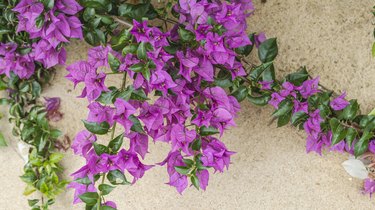
Native to the high altitude regions of Central and South America, the fuchsia plant (Fuchsia spp.) requires mild winters to grow as a perennial. This might suggest to you that the plant would be perfect for Florida's warm climate. But this beauty is happiest and thrives best in locations with cool summers, which of course just don't occur in the Sunshine State. This makes fuchsia culture a bit complicated for Floridians, but not impossible.
Fuchsia Plants for Florida
Video of the Day
U.S. Department of Agriculture plant hardiness zones 8 through 11a cover Florida. The plant most people think of as fuchsia is a hybrid of two fuchsia species and commonly called ladies' eardrops (Fuchsia x hybrida), and it grows as a perennial in USDA zones 9 through 11, which include central and southern Florida. Other fuchsia species include the hardy fuchsia (Fuchsia magellanica), which is perennial in USDA zones 6 through 9 so grows well in northern and central Florida.
Video of the Day
Cultivars of ladies' eardrops and hardy fuchsia are available and may have different USDA zones from their parent plants. Because all climates in Florida are hot and humid in summer, the state's gardeners should choose heat-tolerant fuchsia cultivars. Usually, fuchsia varieties with orange or red flowers are more tolerant of heat and humidity than the ones with lighter-colored or blue flowers.
The Right Place
Fuchsia plants require bright light, but direct afternoon sunlight is too hot for the plants. Put the plants where they will receive bright, indirect sunlight most of the day and afternoon shade. Fuchsias grow best when provided shelter from strong wind. A light breeze can help keep them cool, but stronger winds are too drying and may damage the plants.
Most Florida soils are sandy, though clay soils are found a few northern and central Florida locations, and some peat-based soils are in central and southern Florida. Fuchsias grow best in rich, well-drained soil with a pH between 6.0 and 7.0. So amending most kinds of Florida's soils is necessary before planting fuchsias.
Peat-based soils don't need amendments. For sandy soil, add peat, compost or well-rotted manure to improve moisture and nutrient retention. For clay soil, add peat and wood chips or shredded bark to improve drainage. Apply a 2- to 3-inch-thick layer of the amendments to the soil surface, and then work the amendments into the soil to a depth of 6 to 8 inches.
Growing Fuchsia Plants in Containers
Fuchsia plants grow well in containers. In central and southern Florida, ladies' eardrops fuchsia can grow in a container outdoors year round. In northern Florida, however, the only way to keep ladies' eardrops alive during winter is to grow it in a container and move the container indoors before the first fall frost.
Select a container that is only slightly larger than the nursery container in which your fuchsia grows, and ensure the new container has bottom drainage holes. You can pot the fuchsia in a slightly larger container each spring when the plant's new growth starts or replant the fuchsia in the same container with minor pruning of the plant when it reaches the size you want it to be. Wiping your pruning tool with rubbing alcohol before and after pruning will help prevent the spread of plant diseases.
If you live in northern Florida and take a potted ladies' eardrops indoors before cold weather, cut the plant back to 6 inches tall when you move it indoors, and keep it in a location where the temperature remains 45 to 50 degrees Fahrenheit during winter. Water the plant's soil just enough during winter to keep it from completely drying out. In spring, move the plant to a location with bright, indirect light, and water its soil on a regular basis to prompt new plant growth.
Water and Fertilizer
When you water and fertilize fuchsias depends on how long the growing season is where you live. In northern Florida, the growing season lasts from mid-March through early December. Central and interior Florida's growing season lasts from early February through late December. On the southern coast and the Keys, the growing season lasts all year.
During the growing season, both ladies' eardrops and hardy fuchsias need enough water to keep their soil moist but not soggy. Often, they need watering every day or every other day during the heat of summer. If you have fuchsias in containers, water their soil when its top is dry to the touch. Because fuchsias do not do well in high humidity, water the soil directly and avoid misting the plants' leaves.
Whether you have fuchsias in the ground or in containers, fertilize them every two to four weeks throughout the growing season. Use a complete, water-soluble plant food and apply it to the soil in place of a regular watering after diluting it in water.
Always read and follow label directions for your specific fertilizer, however. If you grow fuchsias in containers in USDA zones where the plants do not grow as perennials, then stop fertilizing those plants two weeks before you plan to take them indoors for winter.